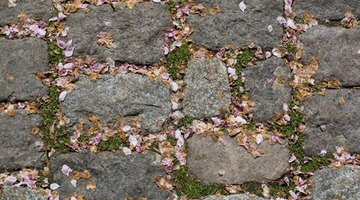How to Lay Portage Stone From Lowe's
Lowe’s portage stone is a product for use in outdoor garden and yard projects. The stone is essentially a type of paving stone with which you can create walkways, outdoor patio spaces and more similar to ones made of brick or concrete. Once installed, the portage stone resembles naturally found uncut stone.

However it is actually precisely designed to be fit into a natural-looking interlocking pattern of any size.
Laying Lowe's Portage Stone
-
Prepare your surface for laying the portage stones. Because the stones are heavy and designed for outdoor use, the preparation does not need to be too time-consuming. You simply need a relatively flat and soft surface. The ideal surface to place the stones on is dirt, but if you are working on grass or some other material you may consider pouring down an even layer of loose sand to create a flat surface in which the stones will set.
-
Mark the center of the area you wish to cover in portage stone. This does not have to be precise, as the entire idea of the stone is to appear relatively natural and not perfectly cut or sized. Simply start in an area that you know you will be working outward from in all directions.
-
Place three of the portage stones together at this central point in a cloverleaf pattern. Each of the portage stones are cut to form a six-sided figure. At one end of the figure, two sides come together in a point, while at the other they come together in a much shallower, almost flat joint. Place three stones together with these nearly-flat sides interlocking to create the cloverleaf.
-
Place down the remaining stones, working outward from each edge of the cloverleaf. Because of the way the portage stones are cut there is only one way each will fit in the spaces between the cloverleaf. As you place more stones, more areas will be created for the next stones. By working outward you can then fill in all of the desired area without worrying about running into a situation where one stone does not neatly fit.
-
Stomp down all the portage stones with either a rubber mallet or your feet. This will ensure the stones work their way securely into the base material below them.
-
Pour setting sand across all the crevices between each portage stone. The setting sand is used to fill in the cracks and keep the stones from moving around between each other.
-
Use a broom to gently sweep away any excess setting sand that did not make its way into the crevices between the stones.
-
Allow at least 24 hours for the stones to sit in the elements before walking on them regularly. This will allow them to fully set into a more permanent position.
Things You Will Need
- Portage stones
- Heavy-duty rake
- Setting sand
- Broom
- Rubber mallet
References
Writer Bio
Brian Walker is an experienced writer who has contributed content to a number of print and online mediums, including major players in the financial, sports and news markets. His work has appeared on eHow.com, Associated Content, Yahoo and even financial news outlet TheStreet.com. He is a graduate of the University of South Carolina and holds a Bachelor of Arts in broadcast journalism.
Photo Credits
- paving stones image by berean from Fotolia.com
- paving stones image by berean from Fotolia.com
More Articles



